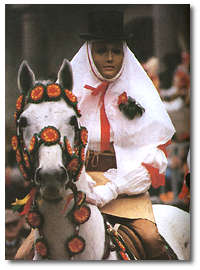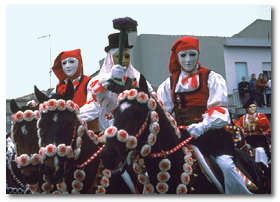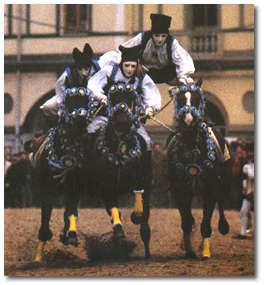 |
|
At the end, "Su Cumpoidori"
rides out wearing a black top hat, a mantilla, a shirt decorated in puff and lace, a vest and a
leather belt. At first sight he looks a bit bizarre. A white mask adorned with strips of silk
disorientates the neophyte’s view. The profound expression of this mask transforms "Su
Cumpoidori", making him unapproachable and unreachable. From that moment onwards, till the end
of the race, "Su Cumpoidori" becomes a demigod descended among mortals to give them good
luck and to send away the evil spirits.
"Su Cumpoidori" is handed the "Sa Pippia de Maju" which is a bunch of
periwinkle flowers wrapped in a green cloth on which a double bunch of violets, symbolizing fertility
and spring, is attached.
|
At the end of the race, the "Su
Cumpoidori waves "Sa Pippia" towards the crowd, giving his blessing.
The horse is taken into the house where "Su Cumpoidori" is waiting on the table. He must
mount the horse without touching the ground. As he leaves the house the crowd celebrates.
The "Su Cumpoidori" rides along the route to the Tournament with his vice "Capi
Corsa", "Su Segundu and Su Terzu Cumpoi".
|
|
 |
The rites have not finished yet. The
procession reaches "Sa Xea Manna" where the star is suspended. The "Su Cumpoidori"
passes three times under the star, crossing his sword with "Su Segundu". The trumpet blares
and the roll of drums give the go-ahead signal. The tournament can start.
|
 |
|
"Su Cumpoidori" has the task of starting the Race to the Star, followed by his two vice
"Capi Corsa" and, then by scores of horsemen. The number of stars the horsemen manage to
get will indicate how lucky or unlucky the following year will be. At the end, "Su
Cumpoidori" and his two vice "Capi Corsa" try to string the Star using "Su
Stoccu", which is a wooden carved stick. Before the acrobatic and daring tricks start Su
Cumpoidori has to perform the last rite called "Sa Remada", where the he has to gallop
along the route lying on his back. The tricks performed on horseback draw fear and amazement from the
crowd till the sunset.
The Sartiglia is only considered finished and the rites respected when the "Sa Remada is
finished.
|
However this is only a simple pause,
waiting for the next Sartiglia when the crowd will identify itself with that hero once again, which
is man and woman together, the main character of a pagan and Christian ceremony which has not changed
for centuries, perhaps for millennia.
|
|